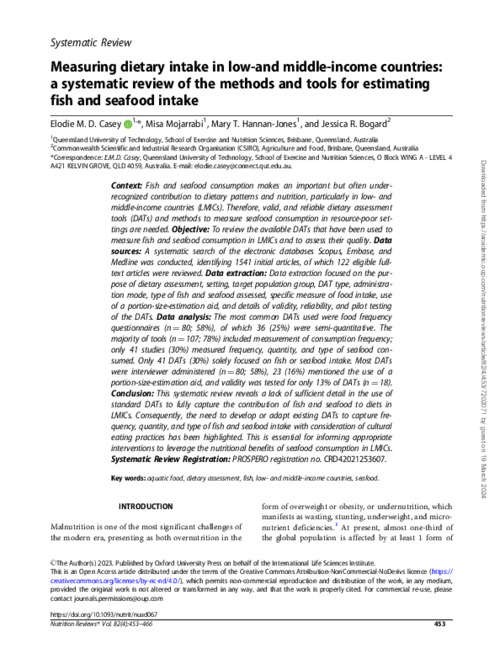Please use this identifier to cite or link to this item:
https://hdl.handle.net/20.500.12348/5866
Measuring dietary intake in low-and middle-income countries: a systematic review of the methods and tools for estimating fish and seafood intake
| dc.creator | Casey, E.M. | en_US |
| dc.creator | Mojarrabi, M. | en_US |
| dc.creator | Hannan-Jones, M.T. | en_US |
| dc.creator | Bogard, J. | en_US |
| dc.date.accessioned | 2024-03-19T18:32:09Z | |
| dc.date.available | 2024-03-19T18:32:09Z | |
| dc.date.issued | 2023 | en_US |
| dc.identifier.citation | Elodie Casey, Misa Mojarrabi, Mary Hannan-Jones, Jessica Bogard. (19/6/2023). Measuring dietary intake in low-and middle-income countries: a systematic review of the methods and tools for estimating fish and seafood intake. Nutrition Reviews, 82 (4). | en_US |
| dc.identifier.issn | 0029-6643 | en_US |
| dc.identifier.uri | https://hdl.handle.net/20.500.12348/5866 | |
| dc.description.abstract | Context: Fish and seafood consumption makes an important but often under-recognized contribution to dietary patterns and nutrition, particularly in low- and middle-income countries (LMICs). Therefore, valid, and reliable dietary assessment tools (DATs) and methods to measure seafood consumption in resource-poor settings are needed. Objective: To review the available DATs that have been used to measure fish and seafood consumption in LMICs and to assess their quality. Data sources: A systematic search of the electronic databases Scopus, Embase, and Medline was conducted, identifying 1541 initial articles, of which 122 eligible full-text articles were reviewed. Data extraction: Data extraction focused on the purpose of dietary assessment, setting, target population group, DAT type, administration mode, type of fish and seafood assessed, specific measure of food intake, use of a portion-size-estimation aid, and details of validity, reliability, and pilot testing of the DATs. Data analysis: The most common DATs used were food frequency questionnaires (n = 80; 58%), of which 36 (25%) were semi-quantitative. The majority of tools (n = 107; 78%) included measurement of consumption frequency; only 41 studies (30%) measured frequency, quantity, and type of seafood consumed. Only 41 DATs (30%) solely focused on fish or seafood intake. Most DATs were interviewer administered (n = 80; 58%), 23 (16%) mentioned the use of a portion-size-estimation aid, and validity was tested for only 13% of DATs (n = 18). Conclusion: This systematic review reveals a lack of sufficient detail in the use of standard DATs to fully capture the contribution of fish and seafood to diets in LMICs. Consequently, the need to develop or adapt existing DATs to capture frequency, quantity, and type of fish and seafood intake with consideration of cultural eating practices has been highlighted. This is essential for informing appropriate interventions to leverage the nutritional benefits of seafood consumption in LMICs. | en_US |
| dc.format | en_US | |
| dc.language | en | en_US |
| dc.publisher | Oxford University Press (OUP) | en_US |
| dc.rights | CC-BY-NC-ND-4.0 | en_US |
| dc.source | Nutrition Reviews;82,(2023) | en_US |
| dc.subject | low- and middle-income countries | en_US |
| dc.subject | seafood | en_US |
| dc.subject | aquatic food | en_US |
| dc.title | Measuring dietary intake in low-and middle-income countries: a systematic review of the methods and tools for estimating fish and seafood intake | en_US |
| dc.type | Journal Article | en_US |
| cg.contributor.funder | Australian Center for International Agricultural Research | en_US |
| cg.contributor.project | A nutrition-sensitive approach to fisheries management and development in Timor-Leste and Nusa Tenggara Timur Province, Indonesia | en_US |
| cg.subject.agrovoc | fish | en_US |
| cg.subject.agrovoc | dietary assessment | en_US |
| cg.subject.agrovoc | fish | en_US |
| cg.contributor.affiliation | Commonwealth Science and Industrial Research Organisation | en_US |
| cg.contributor.affiliation | Queensland University of Technology | en_US |
| cg.identifier.status | Open access | en_US |
| cg.identifier.ISIindexed | ISI indexed | en_US |
| cg.description.theme | Resilient small-scale fisheries | en_US |
| cg.description.theme | Value chains and nutrition | en_US |
| dc.identifier.doi | https://dx.doi.org/10.1093/nutrit/nuad067 | en_US |
| cg.creator.id | Jessica Bogard: 0000-0001-5503-5284 | en_US |
